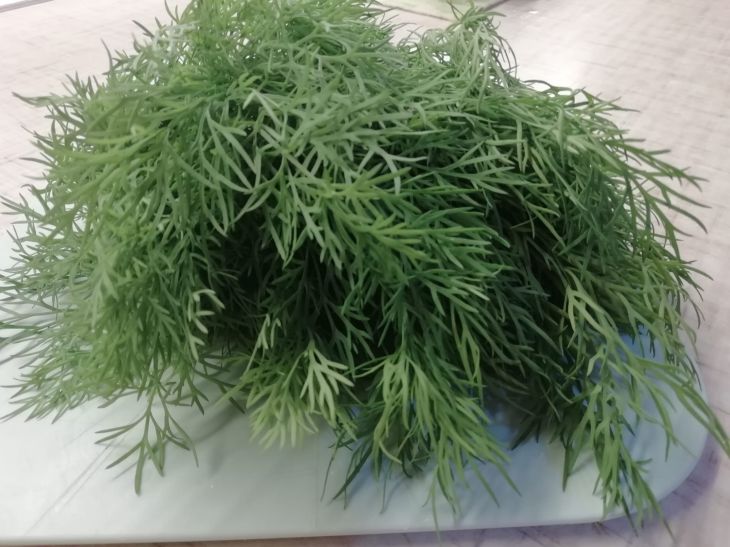Dill is one of the most popular and useful plants in cooking.
Many summer residents grow it on their plots, but it often happens that dill begins to turn yellow.
Anastasia Kovrizhnykh tells us what to do in such a situation and how to preserve your harvest.

Why does dill turn yellow?
First, let's look at the reasons why dill turns yellow.
Typically, this problem can be caused by several factors, such as:
- Lack of nutrients such as nitrogen, phosphorus and potassium, which are necessary for healthy plant growth.
In this case, it is recommended to add fertilizers containing the necessary nutrients.
- Improper plant care, including improper watering, insufficient fertilizing or pruning. If you have such problems, it is recommended to seek advice from experienced gardeners or read specialized literature.
- Diseases or pests that can attack the plant and cause yellowing of the leaves. In this case, it is necessary to use appropriate means of protection or contact specialists to conduct a soil analysis and identify the cause of the problem.
Lack of water
Dill requires regular watering, and if the soil is too dry, it begins to turn yellow. Check the moisture level of the bed and water the dill if necessary.
Nutrient deficiencies
Dill needs enough nutrients to grow healthy and strong.
If the soil does not contain enough essential minerals, yellowing wilt may occur. It is recommended to use fertilizers to maintain soil fertility.
Diseases and pests
Yellowing dill may be a sign of disease or pests. If you notice that the dill leaves are spotted, discolored, or covered in webbing, this may indicate disease.
In this case, you need to contact a professional gardener or use chemicals.
How to preserve dill
If you want to grow healthy and strong dill, you need to decide on some important points. Here are some tips that will help you grow high-quality dill:
Choose the right landing site
Dill loves light and moisture, so choose a place with enough sunlight and water. Also, try to choose a place where there are no strong winds that can damage the plants.
Prepare the soil properly
Dill prefers loose and fertile soil. Before planting dill, prepare the soil by adding compost or humus.
Increase the amount of watering
As mentioned, lack of water can be the reason for dill turning yellow. Water the plants regularly and monitor the soil moisture level. However, do not let the bed dry out, as this can lead to other problems.
Remove the weeds
Dill does not like competition, so try to remove all weeds growing near the plants. This will help the dill get all the necessary nutrients.
Use fertilizers
Dill needs nutrients to grow healthy and strong. Use fertilizer to provide the plants with everything they need.
Protect from pests
Dill can be attacked by various pests, such as aphids and moths. Use pest control products to prevent damage to the plants.
We hope these tips will help you grow healthy and strong dill.
How to properly care for dill
Dill is a plant that needs to be provided with nutrients to grow healthy. You can use organic fertilizers such as compost or chemicals, but it is important to follow the instructions on the package.
However, it is not only the nutrients that are important for the health of dill. It is also necessary to treat the plants if you notice diseases or pests. In this case, you can use chemicals or ask a professional gardener for advice.
If your dill has started to turn yellow due to overheating, you need to create shade for it. To do this, you can cover it with fabric or mesh to provide the plant with additional shade.
Thus, proper care of dill requires not only nutrients, but also proper treatment and protection of the plant. Following these simple tips, you can grow healthy and strong dill on your plot.
Conclusion
Dill is an important crop in the garden, and its yellowing leaves can be a sign of various problems. But do not panic and immediately pull the plants out of the garden bed.
Follow the tips we have provided above and you will be able to keep your harvest healthy and strong.
Dill is one of the most popular and useful plants in cooking.
Many summer residents grow it on their plots, but it often happens that dill starts to turn yellow. What to do in such a situation and how to preserve your harvest? Let's figure it out.
Why does dill turn yellow?
First, let's look at the reasons why dill turns yellow.
Typically, this problem can be caused by several factors, such as:
- Lack of nutrients such as nitrogen, phosphorus and potassium, which are necessary for healthy plant growth.
In this case, it is recommended to add fertilizers containing the necessary nutrients.
- Improper plant care, including improper watering, insufficient fertilizing or pruning. If you have such problems, it is recommended to seek advice from experienced gardeners or read specialized literature.
- Diseases or pests that can attack the plant and cause yellowing of the leaves. In this case, it is necessary to use appropriate means of protection or contact specialists to conduct a soil analysis and identify the cause of the problem.
Lack of water
Dill requires regular watering, and if the soil is too dry, it begins to turn yellow. Check the moisture level of the bed and water the dill if necessary.
Nutrient deficiencies
Dill needs enough nutrients to grow healthy and strong.
If the soil does not contain enough essential minerals, yellowing wilt may occur. It is recommended to use fertilizers to maintain soil fertility.
Diseases and pests
Yellowing dill may be a sign of disease or pests. If you notice that the dill leaves are spotted, discolored, or covered in webbing, this may indicate disease.
In this case, you need to contact a professional gardener or use chemicals.
How to preserve dill
If you want to grow healthy and strong dill, you need to decide on some important points. Here are some tips that will help you grow high-quality dill:
Choose the right landing site
Dill loves light and moisture, so choose a place with enough sunlight and water. Also, try to choose a place where there are no strong winds that can damage the plants.
Prepare the soil properly
Dill prefers loose and fertile soil. Before planting dill, prepare the soil by adding compost or humus.
Increase the amount of watering
As mentioned, lack of water can be the reason for dill turning yellow. Water the plants regularly and monitor the soil moisture level. However, do not let the bed dry out, as this can lead to other problems.
Remove the weeds
Dill does not like competition, so try to remove all weeds growing near the plants. This will help the dill get all the necessary nutrients.
Use fertilizers
Dill needs nutrients to grow healthy and strong. Use fertilizer to provide the plants with everything they need.
Protect from pests
Dill can be attacked by various pests, such as aphids and moths. Use pest control products to prevent damage to the plants.
We hope these tips will help you grow healthy and strong dill.
How to properly care for dill
Dill is a plant that needs to be provided with nutrients to grow healthy. You can use organic fertilizers such as compost or chemicals, but it is important to follow the instructions on the package.
However, it is not only the nutrients that are important for the health of dill. It is also necessary to treat the plants if you notice diseases or pests. In this case, you can use chemicals or ask a professional gardener for advice.
If your dill has started to turn yellow due to overheating, you need to create shade for it. To do this, you can cover it with fabric or mesh to provide the plant with additional shade.
Thus, proper care of dill requires not only nutrients, but also proper treatment and protection of the plant. Following these simple tips, you can grow healthy and strong dill on your plot.
Conclusion
Dill is an important crop in the garden, and its yellowing leaves can be a sign of various problems. But do not panic and immediately pull the plants out of the garden bed.
Follow the tips we have provided above and you will be able to keep your harvest healthy and strong.
Earlier we listed 4 probable reasons why tomatoes did not sprout.









